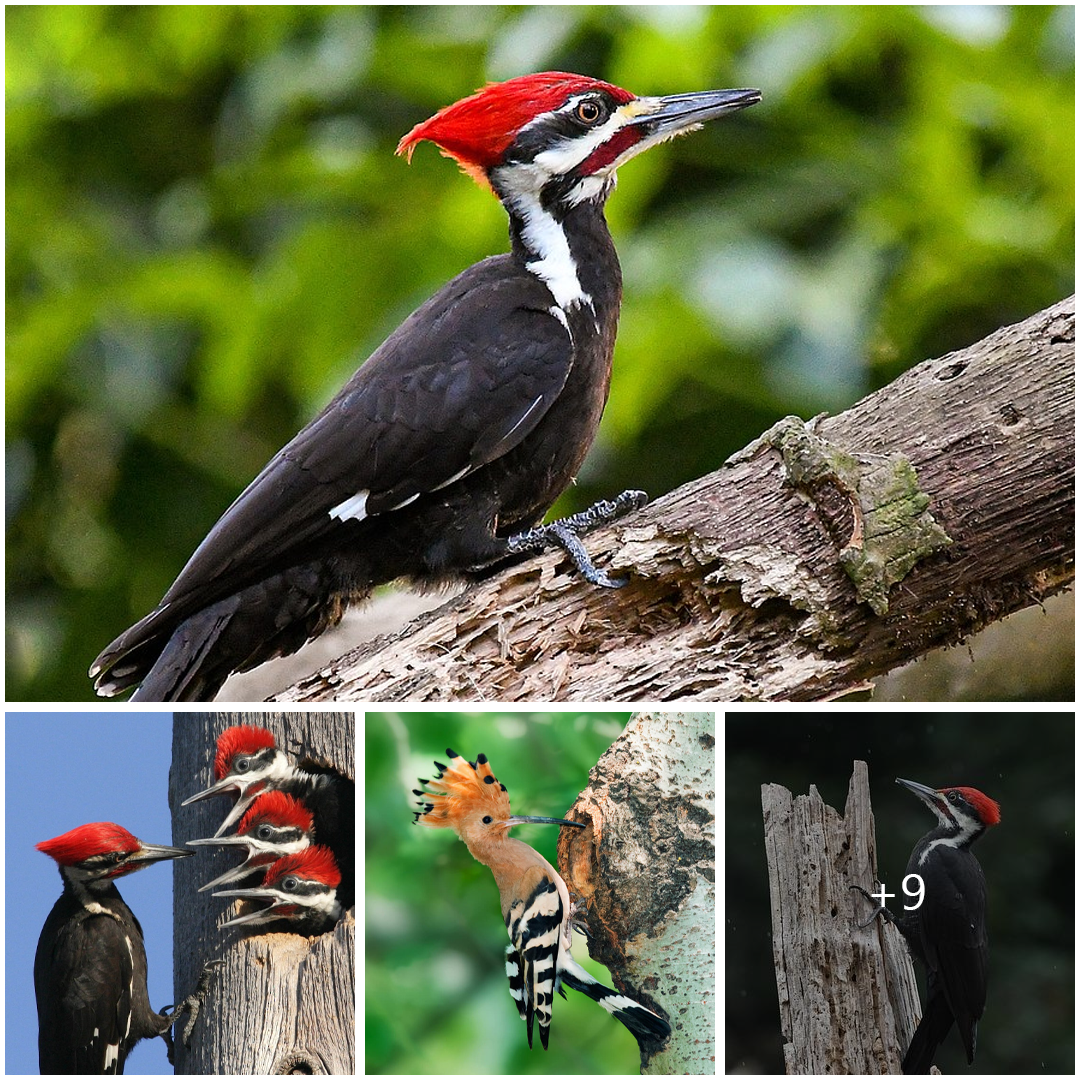
Sitting cross-legged on the mossy forest floor, I try not to make a sound as I swat away mosquitoes. The air is warm, the smell of bright Florida sunshine on moist soil still lingering. But a chill descends as the sun goes down, and crickets venture a twilight chirp. Suddenly I hear a quiet drumming, and then a sound like squeaky dog toys being tossed from tree to tree. “Is that them?” I mouth to Greg Thompson, the Archbold Biological Station scientist spearheading this project. He nods.
We make our way along a path that Thompson had carefully cleared of crunchy palmetto fronds and pine cones. I hold my breath, creeping through the gathering dusk to my spot. Thompson tiptoes to a longleaf pine with a white ring painted around its trunk, the mark of a nesting tree. He raises something like a butterfly net attached to an extendable pole, slowly, quietly, until it reaches a hole in the trunk about 20 feet up. Mary Marine, a research assistant, appears from among the palmettos in a plaid shirt and rubber boots and begins slapping the tree trunk until a little bird about the length of a dollar bill dives out of the hole and into Thompson’s net. Moments later, Thompson is cradling a rather irritated red-cockaded woodpecker in his hand.
“Male. Purple-green, shrimp, yellow, dash, yellow, aluminum,” Thompson says, reading out the colors of the bird’s leg bands to confirm it’s the one they wanted to capture, called “95H Male.”
This is only the beginning of a very long night for that little male. The next step is to rendezvous with the other biologists and volunteers carrying nine other birds captured from around the Osceola National Forest, each safely nestled in a fabric-lined box for the four-hour drive to their new home, so they can repopulate an area where they used to thrive.
/https://tf-cmsv2-smithsonianmag-media.s3.amazonaws.com/filer_public/ae/0a/ae0a8b3a-f6f0-429f-9b9d-e01ed69faf43/aprmay2024_l04_woodpeckers.jpg)
/https://tf-cmsv2-smithsonianmag-media.s3.amazonaws.com/filer_public/e6/22/e6222d80-5bea-4b85-b06a-5cd66ef73bf8/aprmay2024_l03_woodpeckers.jpg)
pine tree in its new home. Jen Guyton
Their destination? Avon Park Air Force Range, central Florida, the largest military bombing and gunnery range east of the Mississippi.
The words “bombing range” might evoke a desolate war zone. Avon Park is anything but. In fact, its 106,000 acres are home to scores of plants and animals that are endemic to Florida, as well as 13 threatened and endangered species, including Florida grasshopper sparrows (North America’s most endangered bird) and Florida bonneted bats (North America’s most endangered bat).
Florida has one of the fastest-growing human populations in the country, with an increase of more than 1,000 people every single day as of 2023. The crush of development, along with the region’s long history of logging and fire suppression, have destroyed 97 percent of the Southeast’s longleaf pine habitat. The almost complete loss of that habitat is why red-cockaded woodpeckers, which rely on pine flatwoods (especially longleaf), have been listed as endangered since 1970. Once present throughout the Southeast in the millions, fewer than 10,000 were left by the 1970s. Now, thanks to conservation efforts, their population is estimated at between 16,000 and 19,000.
/https://tf-cmsv2-smithsonianmag-media.s3.amazonaws.com/filer_public/f6/38/f638a7f8-897e-4b95-968d-db14d719fca3/aprmay2024_l14_woodpeckers.jpg)
The project at Avon Park is a partnership among the Air Force, the U.S. Fish and Wildlife Service and the Conservation of Military Landscapes program at Archbold Biological Station, a research and conservation facility in south-central Florida. “It is intuitively an unusual partnership,” says Buck MacLaughlin, a retired Air Force officer and fighter pilot who is now the range operations officer for Avon Park. “But I do want to stress that it is not an uncommon one. This kind of work, to a varying degree, occurs at all military installations across the country.”
Under the Endangered Species Act and the Sikes Act, the Department of Defense is legally obligated to protect the threatened and endangered species on its lands. In the early 1990s, the Fish and Wildlife Service placed limits on military training at Fort Bragg (now Fort Liberty), the nation’s largest Army base by population, in places within 200 feet of red-cockaded woodpeckers’ nesting areas. The Defense Department is acutely aware that the sooner red-cockaded woodpeckers rebound, the sooner it can stop worrying about the birds interfering with its operations. For now, the ongoing recovery of these woodpeckers relies heavily on places like Avon Park. The longleaf pine forests on military lands are among the last high-quality habitats they have left.
The same is true for hundreds of other creatures. Defense Department lands, with their limits on public access and development, are home to nearly 500 listed species, including lizards, foxes, snakes and many different kinds of birds. Sixty species can be found only on military properties. That’s one reason the Department of Defense, the U.S. Department of Agriculture and the U.S. Department of the Interior came together in 2013 to create Sentinel Landscapes. These are protected areas where those three agencies collaborate to conserve wildlife and ecosystems—where agriculture, natural resources, species habitat and military training needs intersect.
/https://tf-cmsv2-smithsonianmag-media.s3.amazonaws.com/filer_public/82/2d/822d8cf8-7d76-4599-8476-cd28b2f8aa69/aprmay2024_l12_woodpeckers.jpg)
/https://tf-cmsv2-smithsonianmag-media.s3.amazonaws.com/filer_public/72/f7/72f7fb86-373f-4add-8c5c-003300201db5/aprmay2024_l10_woodpeckers.jpg)
/https://tf-cmsv2-smithsonianmag-media.s3.amazonaws.com/filer_public/67/e7/67e74621-143d-419e-b379-652a16a68084/aprmay2024_l06_woodpeckers.jpg)
Conservation measures for the red-cockaded woodpecker have been so successful that in 2020 the U.S. Fish and Wildlife Service proposed down-listing the bird from endangered to threatened. Critics pushed back, pointing out that red-cockaded woodpeckers still rely largely on intensive management, like prescribed burning and artificial cavities installed by people. Unlike most woodpeckers, which excavate their nest cavities in soft, dead trees, red-cockaded woodpeckers peck out cavities in mature live pines. It can take them years to excavate a cavity—though it’s easier if the tree is infected with heart pine disease, a fungus that softens the heart of the tree. But the disease generally only affects trees that are 60 years old or more, and these are in short supply due to extensive logging. As a result, red-cockaded woodpeckers struggle to find trees to excavate. Scientists have found that a lack of available cavities is the main factor limiting red-cockaded woodpecker populations, so installation of artificial cavities is a first-line management tool.
“We’ve known for a long time what to do to recover this species,” says Sarah Lauerman, a red-cockaded woodpecker biologist who manages the translocations from Osceola National Forest. “We’ve been plodding away at that and been really successful. I always joked that I was working myself out of a job.”
Lauerman explains that her forte—moving the birds from one place to another—isn’t the best overall way to tackle the problem. “If you take care of the land, then the rest is pretty easy,” she says. Fire is a key part of this caretaking. Without frequent, low-intensity fires, pine flatwoods can become oak forests or get crowded by woody shrubs, making them unsuitable for species that depend on this habitat. Though lightning (and later, Indigenous people) once started fires in Florida, fire suppression has become common to protect people and development.
/https://tf-cmsv2-smithsonianmag-media.s3.amazonaws.com/filer_public/f1/02/f102f666-322b-4242-976e-56ec4e962cbc/aprmay2024_l11_woodpeckers.jpg)
/https://tf-cmsv2-smithsonianmag-media.s3.amazonaws.com/filer_public/85/69/8569dd3a-b9aa-4cb2-98e9-d7b05bb20781/aprmay2024_l01_woodpeckers.jpg)
/https://tf-cmsv2-smithsonianmag-media.s3.amazonaws.com/filer_public/2e/d4/2ed43ecd-7b96-44bd-ad13-b6799c3353b2/aprmay2024_l05_woodpeckers.jpg)
Avon Park runs a prescribed burning regime, scheduling fires in rotating parts of the range. Bombs used in trainings also can start fires. “Often we’ll let those fires burn as if they were a prescribed fire,” says MacLaughlin. “Not only are those areas around our weapons impact areas safety buffers, but they’re actually really, really high-quality habitat, particularly to the red-cockaded woodpecker.”
Avon Park Air Force Range is the anchor of one of Florida’s two Sentinel Landscapes. Both are key pieces of the Florida Wildlife Corridor, which aims to preserve the last remaining natural path through the Florida peninsula. It’s like a wildlife superhighway, where animals such as the Florida panther and Florida black bear have room to find food and mates.
Keeping these lands wild is a win-win in the military’s eyes: It helps them meet their obligations under the Endangered Species Act, and it also keeps civilians away from training areas that could be dangerous or just downright loud.
The last step is to release the birds into their new home at Avon Park. When we arrived in the middle of the night, the team fanned out across the landscape to put each woodpecker in its designated nest hole. The birds were screened in to prevent them from flying into the night in confusion, which would make them susceptible to predators like owls.
/https://tf-cmsv2-smithsonianmag-media.s3.amazonaws.com/filer_public/e8/7a/e87a42be-2084-4cb6-a94a-595f6487c2f8/aprmay2024_l02_woodpeckers.jpg)
/https://tf-cmsv2-smithsonianmag-media.s3.amazonaws.com/filer_public/14/1d/141d9f9b-cdd3-4a5d-b9ad-bc798392ec4c/aprmay2024_l07_woodpeckers.jpg)
/https://tf-cmsv2-smithsonianmag-media.s3.amazonaws.com/filer_public/47/07/470786d8-5ab4-47db-8513-cd453d9da762/aprmay2024_l08_woodpeckers.jpg)
In the lavender light before sunrise, we’re out among Avon Park’s pines. They’re substantially shorter than in Osceola. “Harsher conditions here,” Thompson tells me. “More hurricanes.” But this is true old-growth longleaf pine, never logged, the ground cover rare cutthroat grass. Some of these trees are more than 185 years old.
Nearby, another scientist waits at a nest hole containing a female red-cockaded woodpecker. Thompson watches through binoculars until his bird begins to peck at the screen covering its nest hole. Thompson’s arm shoots up, and he looks over at his colleague to see if her bird is also awake. When she raises her hand, they both stand and pull, the screens falling away, both birds rocketing out of their trees faster than my eye can follow. They find each other, somewhere in the distance, and their tentative chirps become high-pitched squeaks, like toys chomped by an overexcited Labrador.
Thompson steps back and leans against a tree, his eyes sparkling, pride in his smile. “This is my favorite part,” he says. “They get excited and dance around each other like, ‘Oh my god, who are you? Oh my god, where are we?’” Thompson says he feels like a real estate agent and a matchmaker at the same time, but ultimately he can’t make the birds stick around. Some of them will inevitably fly off to less-protected forest. Still, on average, 70 percent of red-cockaded woodpeckers translocated to Avon Park do stay. In which case, there’s a good chance Thompson and 95H Male will meet again soon.





